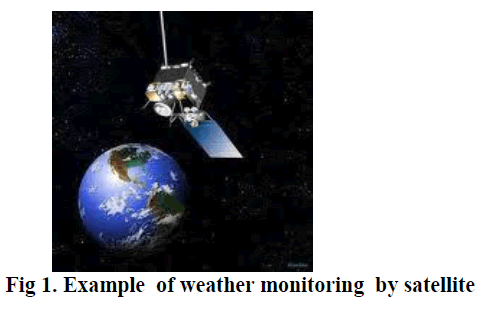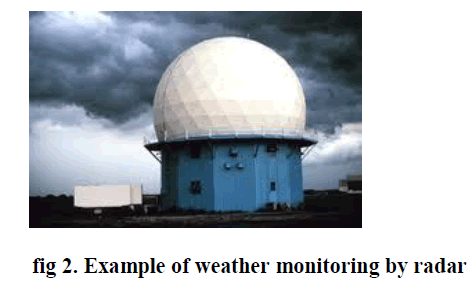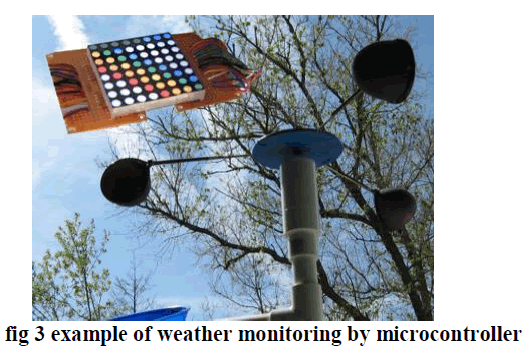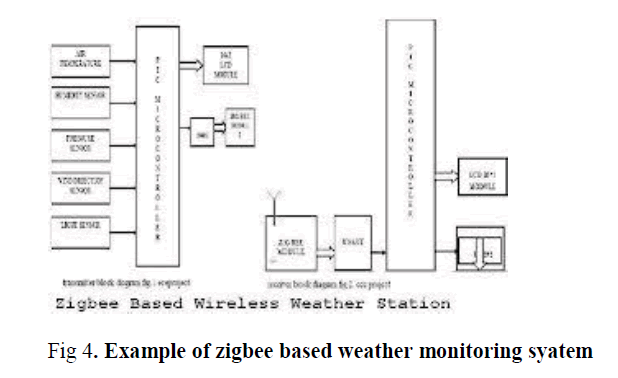ISSN ONLINE(2278-8875) PRINT (2320-3765)
ISSN ONLINE(2278-8875) PRINT (2320-3765)
Setu garg1,Akash chaudhary2, Akash pradhan3, Heena sharma4
|
| Related article at Pubmed, Scholar Google |
Visit for more related articles at International Journal of Advanced Research in Electrical, Electronics and Instrumentation Engineering
In this paper, various weather monitoring techniques have been reviewed. A WMS keeps track of temperature, humidity, barometric pressure, wind speed and direction, etc. The system displays these readings in real time on a display. It also keeps track of historical information on an hourly and daily basis. This historical data can be pulled up on the display at the request of the user. Various techniques are used to monitor the weather like satellites, radars, microcontrollers and many other simple instruments. Weather can also be monitored by using remote wireless sensors. Zigbee is the latest wireless weather monitoring technique.
Keywords |
| Remote wireless sensors, Weather Monitoring System (WMS) , Weather monitoring techniques, Zigbee |
INTRODUCTION |
| Sensing the winds and weather has been important to man over the centuries. Athenians built the eight sided Tower of the Winds in the first century B.C. in honor of the eight gods of the winds. The Tower of the Winds stands to this day in the ancient agora, or market, in Athens. Many significant weather events have affected mankind over the years. Today, the winds and other weather variables are of equal concern and can have an even greater impact on our modern, high-tech life style. Weather affects a wide range of man’s activities, including agriculture, transportation and leisure time. Often the affects involve the movement of gases and particulates through the atmosphere. Modern weather monitoring systems and networks are designed to make the measurements necessary to track these movements in a cost effective manner. In weather monitoring systems, different parameters like time and date, temperature, relative humidity, dew point, barometric pressure and trend, wind direction and speed, wind chill, rainfall amount, and weather forecast are all shown on the LCD display. Temperature, humidity and dew point are indicated for both indoor and outdoor locations. Programmable alarms are also available in the monitoring systems which indicate out-of-range conditions. Thermometer, barometer, and dew point functions have min/max memories. Barometer also features sealevel reference, pressure trend indicator and weather forecasting symbols (sunny, cloudy, and rainy). Serial port permits linking to a PC or laptop for data transfer. System is supplied with sensors, an AC adapter, and four AA backup batteries. The conventional weather monitoring system consisted of individual sensors to measure one meteorological variable, each connected to a data collection device or recorder. Modern technology has allowed the combination of several sensors into one integrated weather station that can be permanentlylocated at one site, or transported to a site where localized weather is needed. |
II. REVIEW OF WEATHER MONITORING TECHNIQUES |
A. Weather monitoring by satellite |
| . The weather satellite is a type of satellite that is primarily used to monitor the weather and climate of the earth. Satellites can be polar orbiting, covering the entire Earth asynchronously, or geostationary, covering over the same spot on the equator. |
| The first weather satellite, Vanguard 2, was launched on February 17, 1959. It was designed to measure cloud cover and resistance, but a poor axis of rotation kept it from collecting a notable amount of useful data. |
| Meteorological satellites see more than clouds and cloud systems. City lights, fires, effects of pollution, auroras, sand and dust storms, snow cover, ice mapping, boundaries of ocean currents, energy flows, etc., and other types of environmental information are collected using weather satellites. Weather satellite images helped in monitoring the volcanic ash cloud from Mount St. Helens and activity from other volcanoes such as Mount Etna. Smoke from fires in the western United States such as Colorado and Utah have also been monitored. |
| Other environmental satellites can detect changes in the Earth's vegetation, sea state, ocean color, and ice fields. For example, the 2002 Prestige oil spill off the northwest coast of Spain was watched carefully by the European ENVISAT, which, though not a weather satellite, flies an instrument (ASAR) which can see changes in the sea surface. |
| The first weather satellite to be considered a success was TIROS-1, launched by NASA on April 1, 1960. TIROS operated for 78 days and proved to be much more successful than Vanguard 2. TIROS paved the way for the Nimbus program, whose technology and findings are the heritage of most of the Earth-observing satellites NASA and NOAA have launched since then. |
 |
B. . Weather monitoring by radar |
| Radar is used to take large scale weather imagery. Radar images allow meteorologists to see up-to-the-minute weather observations of weather formations like cloud systems, storm cells and hurricanes. Radar imagery is particularly useful in times of emergency weather conditions as it provides live coverage of the weather, enabling more accurate warning systems to be put in place. |
| Meteorologists use radar to monitor precipitation. It has become the primary tool for short-term weather forecasting and watching for severe weather such as thunderstorms, tornadoes, winter storms, precipitation |
 |
| types, etc. Geologists use specialized ground-penetrating radars to map the composition of Earth's crust. |
C. Weather monitoring by microcontroller |
| Computers play an integral role in modern weather monitoring, enabling more accurate readings and record keeping. Computers are usually used in conjunction with weather software and externally introduced weather readings from satellites, radar readings or from computerized weather instruments like modern anemometers and thermometers. According to Windmill, computers are used to display, analyze, record and also predict weather patterns. Computers using weather monitoring software anddevices are also often linked to control mechanisms, so that, for instance, when the temperature reaches a minimum level, the computer switches on the heating in a house. |
 |
D. Weather monitoring by using simple instruments |
| For centuries simple technology has been used to monitor weather changes. Basic instruments like a weather vane or anemometer are used to measure wind speed and direction---they are stillsome of the most widely used weather monitoring technologies today. Thermometers, hygrometers, barometers and rain gauges are the basic tools of monitoring weather, without which the more advanced technologies involved in weather monitoring and prediction would be useless. |
E. Wireless zigbee based weather monitoring system |
| In an industry during certain hazards is will be very difficult to monitor the parameter through wires and analog devices such as transducers. To overcome this problem we use wireless device to monitor the parameters so that we can take certain steps even in worst case. Few years back the use of wireless device was very less, but due the rapid development in technology, now-a-days, we use maximum of our data transfer through wireless like Wi-Fi, Bluetooth, Wi-Max, etc. A wireless weather monitoring system which enables to monitor the weather parameter in an industry or anywhere, can also be designed by using Zigbee technology. The parameters can be displayed on the PC’s screen. The system contains two parts. One is transmitter node and another one is receiver part and both can be any number. The transmitter part consists of whether sensors, microcontroller and Zigbee and the receiver part consist of a PC interfaced with Zigbee through PC serial port. The system monitors temperature, wind speed, wind direction and humidity with the help of respective sensors. The data from the sensors are collected by the micro controller and transmitted to the receiver section through wireless medium. All theparameters are viewed by the pc using program in the receiver side. |
 |
III. CONCLUSION |
| Various weather monitoring techniques have been reviewed. Among all the technologies Zigbee is the most promising technological standard for low data rate, and has a long battery life. Zigbee networks are reliable and self healing. These networks are easy to deploy and hence are cheaper as compared to other techniques. Today main issue is complexity of zigbee networks. The main problem is its security because intruders can easily hack zigbee networks and too much technology makes people lazy. The evolution of zigbee technology is a big achievement, which will likely to be targeted for use in application such as road map tracking, medical application, consumer’s electronics, pc, personal health care, residential and commercial control and many more by applying different actions. |
ACKNOWLEDGMENT |
| We have great pleasure in presenting this review paper on my project, that is ZIGBEE BASED WHEATHER MONITORING SYSTEM. (I would like to acknowledge with a deep sense of gratitude and in deptness to Mrs Monica Jain (HOD.) Who trusted me and gave me the opportunity to work n this project. My special thanks to all the teachers, who helped me in every possible way throughout the project. They provided the easiest possible solution to my problem which was helpful for me in development of the project. Last but not least I am thankful to MRS. SETU GARG(our project mentor) for the kind of support. |
References |
|